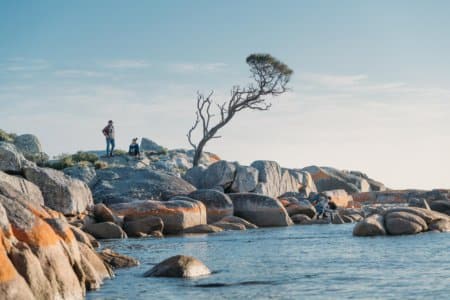It all begins with curiosity. All research, all study, in some way, originates with someone asking a question.
How do I build a stronger bridge? Can I take a photo of a black hole? Did Shakespeare really write Romeo and Juliet? Is there a better way to care for people with dementia?
Curious people – both staff and students – are among the most valuable assets a university can have. Because great discoveries aren’t made by people who think they know all the answers.
They’re made by the people who ask questions.
And, at the University of Tasmania (UTAS), you’ll find many of them.
The world’s #1 university for climate action really loves people who ask questions. In fact, curiosity, inquiry, and innovation are virtually a way of life in Tasmania, helping the university become one of the world’s top 300 universities for academic research. (2023 Academic Ranking of World Universities).
The island state is a beautiful place, full of natural wonders. But being a relatively small place, surrounded by water, does come with its challenges. And this place has a long history of people adapting to – and thriving in – its unique conditions, going back thousands of years.

Source: University of Tasmania
From the highly specialised and ancient hunting and harvesting techniques of the Tasmanian Aboriginal peoples, to more recent adaptations like its hugely diverse agricultural industry, and ambitious hydroelectric power scheme, Tasmania has a way of making its inhabitants resilient, self-reliant and inventive.
And just as Tasmania shapes everyone who lives here, it also shapes the university’s courses and the way they’re delivered.
The university’s community is a strongly interconnected one, with an amazing variety of industries, and a thriving arts and creative scene, all influenced by Tasmanian life and conditions.
And the University of Tasmania works closely and collaboratively with many of these industries and sectors, simultaneously feeding their knowledge and expertise into the university, and allowing its students to work directly with the people they might one day call colleagues.
This spirit of close connection also allows for a focus on project-based and career-focused learning, so students can learn in real-world environments to gain the skills they will actually need after they graduate.
Because not all classrooms have four walls.
The University of Tasmania’s renowned School of Architecture and Design is uniquely placed to excite and inspire students in this way. With a focus on sustainable and ethical designs that are sympathetic to the distinctive landscape and environment all around us, students learn through active experimentation.

Source: University of Tasmania
Teaching concentrates on place-based design questions, often seeing students working on real-world projects. This helps students to foster professional, industry, and community relationships as part of their degree.
The university’s newly refurbished Architecture and Design building in Launceston is specially designed to promote this spirit of collaboration and innovation, with new workshops, student-occupied studios, a student-led gallery, and dedicated object-making spaces.
And, when they graduate, students leave with a portfolio of designs and models that aren’t just theory-based, they have been tested in real-world situations in partnership with the school’s community.
The University of Tasmania’s School of Nursing is also closely aligned with the local health industry and Bachelor of Nursing graduates have an enviable reputation in the workforce, making them highly sought-after.

Source: University of Tasmania
Much like Architecture students, Nursing students also have the opportunity to train extensively on-the-ground in Tasmania’s hospitals, as well as various other city and regional health services across the state. Students are required to complete at least 800 hours of Professional Experience Placements as part of their degree.
This ensures that graduates have both a broader level of knowledge and skills, as well as a more nuanced understanding of the challenges and conditions that are particular to Tasmania.
Not only are University of Tasmania students taught by experienced, professional nurses, they also train in specialised simulation labs on campus, which realistically mimic hospital wards with simulated patients.
Media and Communication students are embedded with local news outlets to hone their skills. Creative Arts students do internships with some of the state’s most iconic arts festivals. And Business students run a public Tax Clinic to help them practise their accounting skills while also providing a free service to members of the public.

Source: University of Tasmania
As University of Tasmania students learn from the collective experience of their community, they also give back to it. And as they explore their chosen fields, their curiosity leads them to ask the kind of insightful questions that lead to new solutions and ways to make things better.
The University of Tasmania is constantly striving to improve itself as well, by always asking what it can do better. This constant drive for improvement helped the university become the world’s number one university for taking climate action for two years in a row. (Times Higher Education Impact Rankings 2022 and 2023).
Because the university believes the research done by its scientists. Their curiosity is showing everyone how to make the world a better place.
That’s why the world always needs people who ask questions.
And the University of Tasmania wants your curiosity to thrive.
Follow the University of Tasmania on Facebook, Instagram, TikTok, Twitter, YouTube and LinkedIn.













